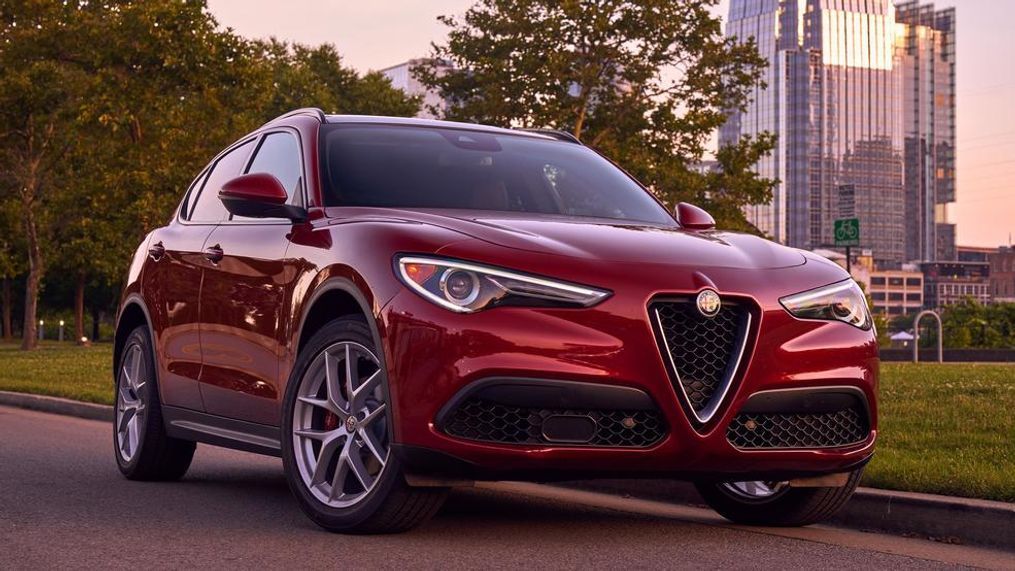2018 Alfa Romeo Stelvio: A uniquely styled compact CUV [Quick Take]
The compact and small SUV market is growing crazy fast. It seems like every time I turn around there’s a new one being launched or revealed.
In the last few months alone, I’ve had the opportunity to test the Jaguar E-Pace, Hyundai Kona, Ford Ecosport and BMW X2 – a wide range of vehicles that go from basic to high-level luxury.
And the onslaught isn’t over. During a recent press preview of the Kona, Hyundai execs said this segment is expected to grow another 16 percent by 2024.
So, how does European brand like Alfa Romeo enter this segment in a new country and try to gain a foothold?
With panache.
The all-new Stelvio SUV is the third vehicle Alfa has brought to the United States, and similar to the 4C and the Giulia, it’s a stunner.
In fact, it’s one of the new vehicles I get asked about the most. How does it drive? What do you think of it? Should I buy it?
Let’s start with this answer: I loved it.
The test vehicle was a Ti version, which means it wasn’t the performance-oriented Quadrifoglio. But it was still really well-powered with a 2.0-liter turbocharged 4-cylinder engine that makes 280 horsepower and 306 pound-feet of torque. For comparison’s sake, that’s 16 less horsepower and 11 more pound-feet of torque than the Jaguar E-Pace R-Dynamic with the top-level engine.
And the Stelvio held its own.
In a quirk of fate, I drove these two vehicles back to back, and though Jaguar doesn’t consider Stelvio to be a competitor, it probably should. Especially since Stelvio is in exactly the same price range.
The Stelvio had a tighter suspension and was a bit more fun in cornering situations, but the E-Pace was zippier and a little quieter.
Both are a blast to drive.
Frankly, I didn’t think the Stelvio would be all that much fun without being the 500-horsepower Quadrifoglio. Yet it was.
The downside of fun: less than stellar fuel economy. EPA estimates that you should get 22 mpg in city driving and 28 mpg on the highway, yet I got around 16 mpg in combined driving.
In addition to the overall performance, I also really liked the unique and curvaceous design.
The triangle grille is somewhat polarizing but absolutely identifiable as Alfa Romeo. I really like the way the exterior was put together and appreciate that the Stelvio doesn’t quite look like anything else on the road.
The interior is clean and simple, with easy-to-use knobs and dials. Unlike the 4C, Stelvio eschews the push-button gearing and opts for a regular levered gearshift – which is more mainstream and easier to digest. One quirky thing I did not get used to during the test period: The push-button start is on the steering wheel.
The test vehicle had the Ti AWD Sport Package, which included the leather sport seats, bright aluminum pedals, power adjustable bolster and aluminum interior accents, which made the interior both comfortable and sporty.
All-wheel drive is standard on all Stelvio models, and all trims get the 2.0-liter engine, except the Qadrifoglio, which upgrades to the 2.9-liter twin-turbo V-6.
Stelvio ($43,440): This trim comes standard with features such as leather seats, passive entry, push-button start, dual-zone climate control, a front USB port, a 6.5-inch AM/FM radio display and dual rear-charge USB ports.
Stelvio Sport (45,240): This trim adds features such as column-mounted paddle shifters, 19-inch aluminum wheels, aluminum interior trim and gloss black window surrounds.
Stelvio Ti ($45,440): This trim adds a heated steering wheel, heated front seats, an 8.8-inch infotainment display, dark gray oak interior trim.
Stelvio Ti Sport ($47,940): This trim adds sport seats, 20-inch sport aluminum wheels, four-way adjustable lumbar and power bolsters and column-mounted paddle shifters.
Stelvio Ti Lusso ($47,940): This is the luxury side of the Ti spectrum, adding luxury Pieno Fiore Italian leathers seats with Cannelloni inserts, leather-wrapped dash, genuine wood trim and luxury-leather wrapped steering wheel.
Stelvio Quadrifoglio ($81,590): The biggest change at this top-tier, high-performance trim is the engine, which upgrades to the 2.9-liter twin-turbo V-6 that delivers 500 horsepower and 443 pound-feet of torque. It also adds a dual-mode quad exhaust system, high-performance Brembo brakes, adjustable performance suspension, high-performance leather and Alcantara seats, a Formula One inspired steering wheel and a top speed of 177 mph.
The test vehicle was a Ti Sport, and it added some pricey options including the Sport Package, Convenience Package, Driver Assistance Static Package, Driver Assist Dynamic Plus Package, dual-pane sunroof, navigation and Harmon/Kardon premium audio for an as-tested price of $53,640.
The Bottom Line
I really enjoyed my time with the Stelvio. It’s beautiful and fun to drive, and if you’re not opting for the performance-oriented Quadrifoglio, it’s affordable.
But – and this is kind of a biggie – Alfa Romeo has a reputation problem in the United States. Dependability was arguably one reason Alfa Romeo left the U.S. shores more than 20 years ago, and I’m not entirely convinced that the brand has worked out the bugs.
There have already been four safety recalls on the Stelvio during its brief time in the market, and vehicles from Fiat Chrysler Automobiles traditionally land at the bottom of JD Powers Vehicle Dependability Study.
Thus, I think Alfa Romeo needs time to build some credibility.
So, I’ll give you the advice that I gave my sister: If you want this vehicle, lease it. And I rarely tell people to lease. But you’ll get an amazing and unique vehicle without any of the worry. Plus, this gives Alfa time to gain more credibility in the States, and if you still like it after 3 years, you can buy next time around.




